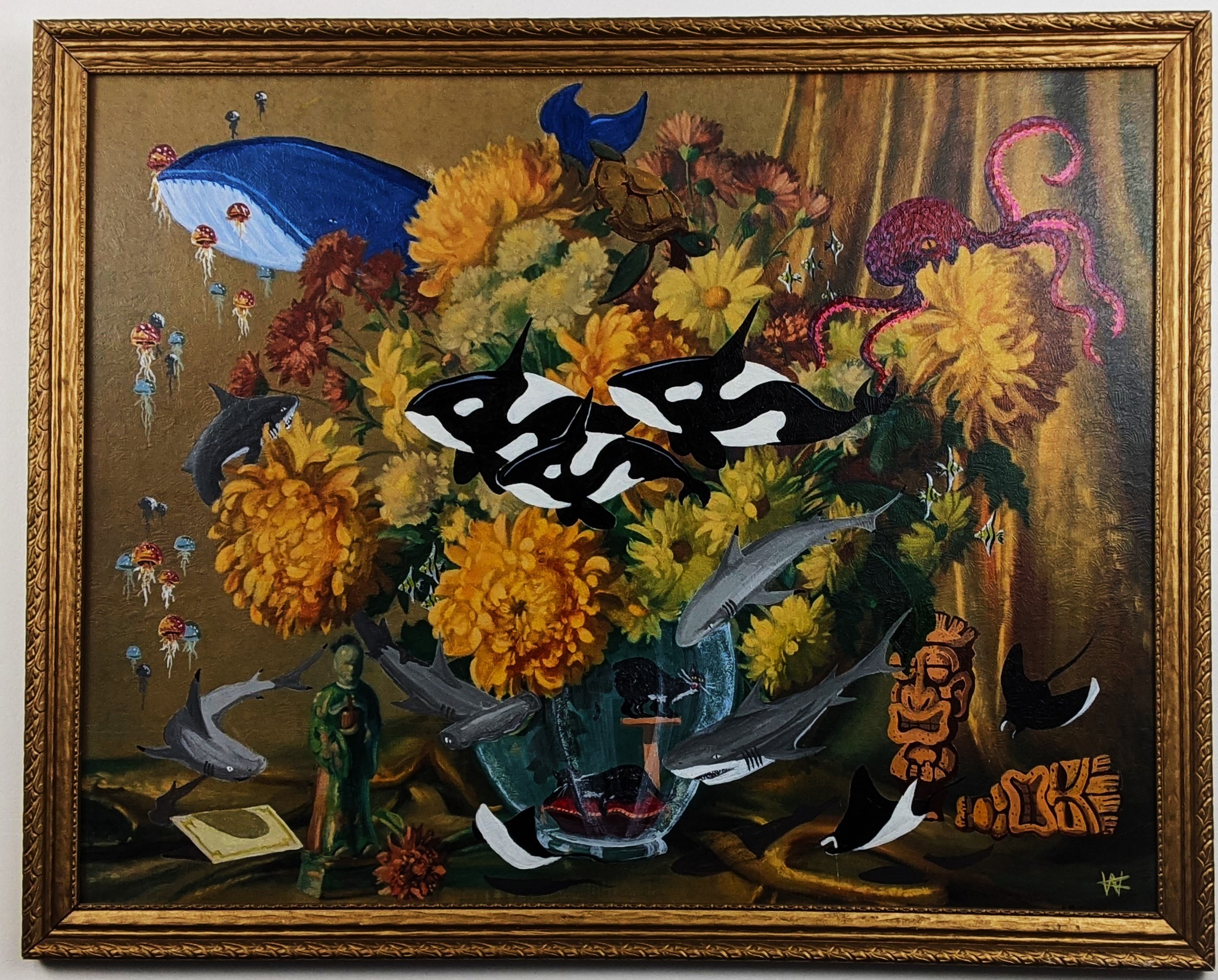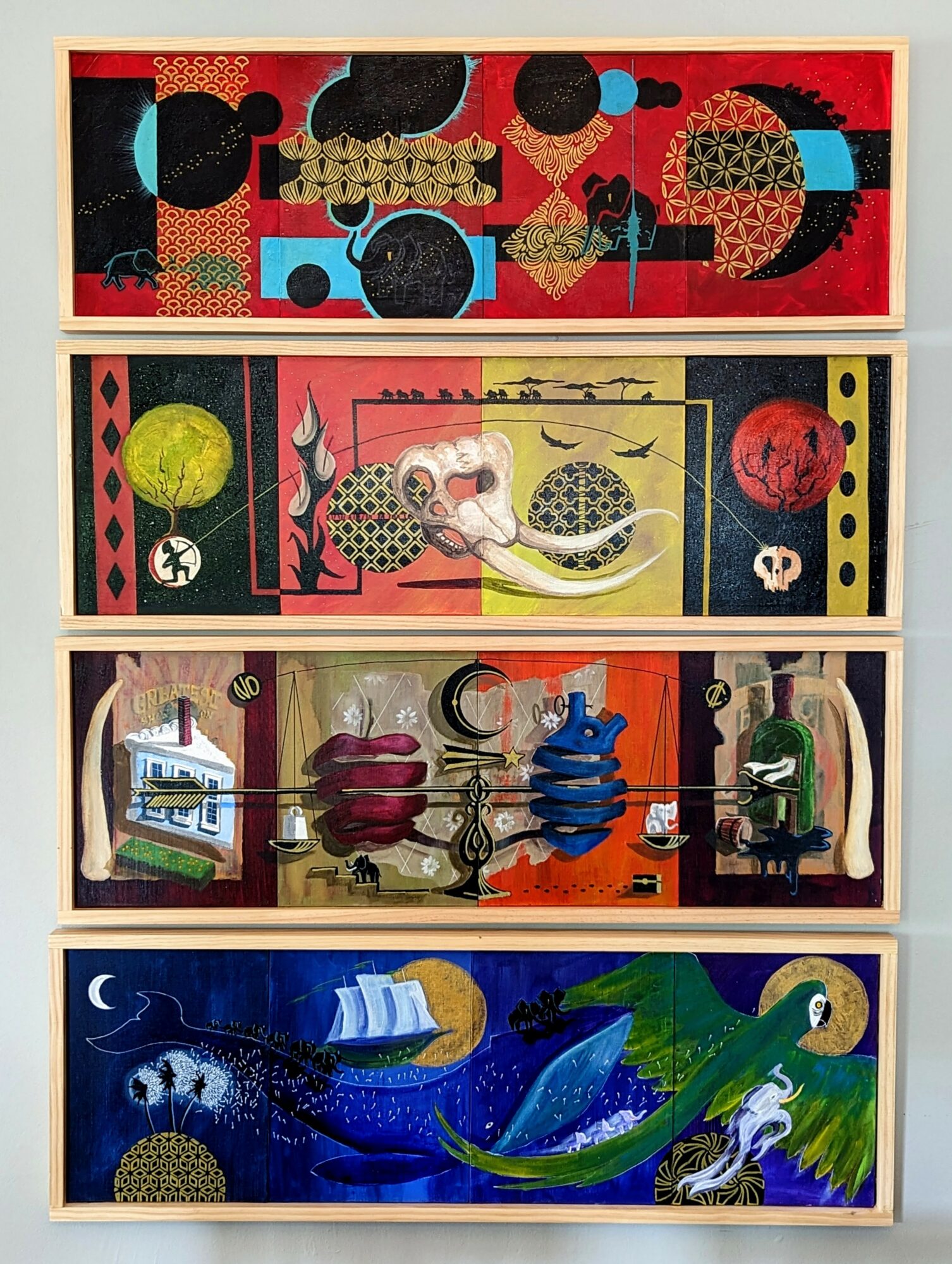

Today we’d like to introduce you to Chip Williamson.
Hi Chip, it’s an honor to have you on the platform. Thanks for taking the time to share your story with us – to start maybe you can share some of your backstory with our readers?
I’m Chip Williamson, an artist and curator based in Dayton, Ohio, where I’ve spent years exploring and experimenting with painting, photography, and the unexpected magic that lies in between. I’m self-taught, which to me has always felt more like an invitation to color outside the lines than a limitation. My work lives in that strange, joyful space between storytelling and surrealism—between the seen and the imagined.
What really drives me is the beauty I find tucked away in the overlooked and forgotten. I’ve always been drawn to the strange charm of found and discarded objects—the things most people pass by without a second thought. I gather these bits and pieces and breathe new life into them, building layered visual narratives that ask people to pause, reconsider, and maybe smile. It’s not just about giving old things a second chance; it’s about showing how even the most mundane objects can become portals to whimsy, wonder, and meaning.
I’m deeply influenced by a mix of sounds, sights, and stories. Jazz—wild and unpredictable—mirrors the flow of my process. Pop Art energizes me with its punch and boldness. Surrealism opens the door to dreamlike spaces I love to play in, while Photorealism reminds me to stay rooted in detail, even when my head’s in the clouds. Artists like Wayne White, Julie B, Paul Rienzo, Jonathan Queen, and the legendary underwater explorer Jacques Cousteau have all helped shape my artistic vocabulary in different ways. And Josh Gates—his adventurous spirit speaks to the explorer in me.
Of course, the most profound influence in my life is my daughter, Lydia. She constantly inspires me—not just as an artist, but as a human being. Her curiosity, humor, and perspective are woven into everything I create.
Then there’s this somewhat unexpected muse: whales. And not just whales, but the entire underwater world. There’s something so mysterious and awe-inspiring about the deep—those slow, majestic creatures, the weird sea life, the eerie quiet of it all. That sense of otherworldly beauty beneath the surface really resonates with me and often bubbles up in my work.
At the end of the day, I see my art as a celebration of the ordinary reimagined. I want people to see the world a little differently—to find delight in the overlooked, to get lost in stories told through odd juxtapositions and quirky transformations. My hope is that each piece invites viewers into a space that feels part fairy tale, part found object collage, and all heart.
I’m sure it wasn’t obstacle-free, but would you say the journey has been fairly smooth so far?
Of course, like any journey worth taking, mine hasn’t been without its share of challenges. Being a self-taught artist is both liberating and daunting. There’s no roadmap, no formal structure—just instinct, curiosity, and a whole lot of trial and error. Early on, that meant battling doubt. It’s easy to feel like an outsider when you don’t have the “right” credentials or when your work doesn’t fit neatly into a category. I had to learn to trust my gut, to believe that what I was doing had value—even if it didn’t look like what anyone else was doing.
Money, time, and space have also been real hurdles. Making art with limited resources forced me to get scrappy, to look at materials in a different way. That’s actually where my love for found objects came from—because they were available, overlooked, and full of hidden potential. What started as a necessity eventually became central to my voice as an artist. The constraint became the concept.
There have been personal obstacles, too—moments of burnout, self-doubt, and the pressure of trying to balance creativity with the realities of life. Being a parent while navigating this path hasn’t always been easy, but it’s also been the most grounding force. My daughter has given me a reason to keep pushing forward, even when it feels like the world isn’t watching. She reminds me why I do this in the first place—not for accolades, but for connection, for curiosity, for joy.
And then there’s the challenge of vulnerability—of putting weird, heartfelt work out into the world and not knowing how it will be received. But that vulnerability has become part of the magic. I’ve come to understand that the most meaningful art often comes from the most uncertain places. The weirdness, the whimsy, the rawness—it’s all real, and it’s all part of the story.
Through it all, I’ve learned to lean into the unknown. I’ve stopped chasing perfection and started embracing process. I’ve built a practice rooted in curiosity, resilience, and play. Every obstacle has offered something—whether it’s a new material, a new way of seeing, or a deeper sense of why I create in the first place.
My work, in many ways, is a reflection of that journey. It’s messy, layered, strange, and joyful—just like life. And if it invites someone else to see beauty where they hadn’t before, or to feel a little less alone in their own weirdness, then I know I’m on the right path.
Thanks – so what else should our readers know about your work and what you’re currently focused on?
Looking ahead, I’m more excited than ever about where this journey is taking me. I feel like I’ve just scratched the surface of what’s possible—not just in terms of materials or mediums, but in how I tell stories and connect with people through my work. I’m exploring new ways to merge my love for curation with my own creations, finding opportunities to build spaces where other artists and storytellers can come together and experiment, too.
I’m also diving deeper into my fascination with the underwater world—thinking more about how those themes of depth, silence, and discovery might inform future pieces. The idea of exploring what’s hidden beneath the surface, both literally and metaphorically, continues to resonate. There’s so much left to say, and so many strange little corners of the world I haven’t yet translated into art.
And as always, I’m staying open—to the unexpected, to the imperfect, to the wildly beautiful. My process will keep evolving, just like I am. But at the heart of it all is still that same impulse: to make something that feels alive, that invites wonder, and that tells a story worth pausing for.
Whether it’s through a painting, a curated space, or a found object transformed into something new, my goal remains the same: to spark curiosity, connection, and maybe even a little joy. Because if there’s one thing I’ve learned through the ups and downs of this path, it’s that art has the power to turn even the messiest bits of life into something meaningful.
And I plan to keep doing just that—one odd, beautiful piece at a time.
Are there any apps, books, podcasts, blogs or other resources you think our readers should check out?
Another essential thread in my creative process is my love for reading—especially fantasy and science fiction. These genres open up entire universes of possibility, and that sense of expansive, imaginative world-building deeply informs how I approach my own art. Authors like Andre Norton and Rebecca Ore sparked my early fascination with the unknown, the mystical, and the otherworldly. Herman Hesse and Paulo Coelho wove spiritual and philosophical undertones into their narratives, which helped me think about storytelling as more than just plot—it became a search for meaning. And Andrzej Sapkowski’s gritty, magical realism in The Witcher series resonates with my own tendency to blur the lines between the surreal and the grounded.
Visually, I’ve always found kinship in the works of René Magritte and Salvador Dalí—how they twist perception and dream logic into something oddly familiar. Their influence shows up in the off-kilter compositions and whimsical tension in my work. Jasper Johns, too, with his bold use of common symbols and recontextualized objects, echoes my own obsession with finding significance in the discarded or overlooked.
Together, these writers and artists feed a part of me that craves both the mythic and the absurd. They remind me that storytelling—whether on the page or the canvas—is about bending reality just enough to reveal something truer underneath. That’s exactly what I aim for with each piece I create.
Contact Info:
- Instagram: @chipwilliamson



























